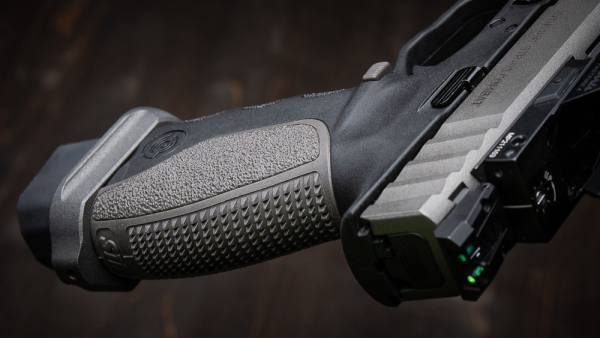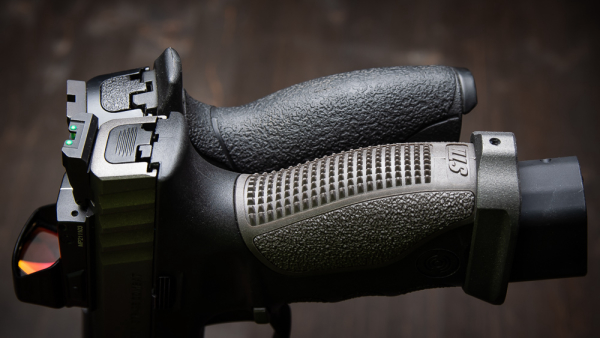
Are we undervaluing the importance of the grip?
That’s the question that came up as Michael Bane, Yamil Sued and I returned to the hotel after spending the day at Gunsite during the Stoeger media event. In talking about the STR-9 line of pistols that Stoeger was showcasing at the event, Bane I and went down a rabbit hole of sorts talking about the grip design.
Whenever people talk about the grip of the gun they are usually talking about you the shooter gripping the gun, especially in the context of training, and how your fingers overlap, where you thumbs rest and how much pressure each hand is exerting on the grip.
The other place that people dive deep into the grip discussion is regarding the angle. The hours spent comparing, or complaining about, the Glock grip and that of the 1911 could fill a lifetime, or two.
Our discussion avoided these areas and instead focused on the grip’s design and textures, and whether the choices made by the designers ventured past simple aesthetics to considered, well thought out enhancements that benefited the shooter.

Bane, who had spent a lot more time with the STR-9S Combat, the Stoeger model we were primarily discussing, prior to this media event and the pistol’s actual release and spoke to the kinds of questions the engineers asked, and end user insights they sought, as they developed the Combat.
All this tracked with what I had experienced first-hand out on the range while shooting the full-sized Combat, and even the much smaller micro compact STR-9MC.
My experience with the Combat began with my shooting it inconsistently. The gun worked great, but somewhere in the process, and thankfully early in the process, I realized my grip wasn’t solid enough to be consistent.
Because the STR-9S Combat has removable backstraps, I stepped off the line and replaced the medium backstrap with the large. This improved the way the gun sat in my dominant hand.
A couple days ago I spoke to George Harris, a well-known trainer and past lead instructor at the Sig Academy. We had worked together at Sig and George has forgotten more about grip than I can ever hope to learn, so I ran my observations by him for some well needed third party confirmation.
He pointed out that people frequently overlook the simple question to gripping the gun, and that is, ‘Does it feel good in your hands?’ Because, as he noted, if the gun feels good in your hands then you are going to shoot it with more confidence.
And that is exactly, to a tee, what happened when I switched out the backstraps.
OK, I know, there are lots of guns with removable backstraps and this isn’t on a par with splitting the atom or curing cancer. However, I haven’t had the experience where a company got it so right like Stoeger did.
There is huge aftermarket business that exists to service shooters wanting to upgrade their grips. Everything from replacement grip modules and grip plates, to custom hand or laser stippling, to adhesive overlays of a sandpaper/skateboard type tape. But these are a secondary step – and expense – that one needs to take to have the gun grip feel good for them.
Stoeger’s efforts in this area didn’t, for an instant, have me thinking about any changes.
What happened specifically is that once I returned to the line and resumed shooting, I was getting positive tactile feedback from the backstrap. Not only did it fit my hand better, but the swath of knurling centered on the back of the grip pushed into the flesh of my lower thumb.
Though not painful, I could definitely feel it. And it told me I was gripping the gun enough to do the real work of reading the red dot while moving the trigger back to the break for an accurate shot.
Now, here’s where it really paid off. For the first couple shots I was thinking about my grip, and was it enough to be accurate. Then I stopped thinking, letting the tactile feedback automatically tell me it was, and then all my mental focus was on the red dot sight and trigger movement – where it should be.
As I said, replacement backstraps are not magic, but their design can indeed assist you with your grip if designed for that purpose.
By comparison, I have the large backstrap installed on an M&P Pro (original recipe and not the 2.0). While it expands the grip its smoother surface does not give me the positive feedback like the backstrap of the STR-9S Combat does.

Now was the knurled backstrap purposely designed to do exactly what I experienced with the Combat? I don’t know because I was not there when they designed it, and I haven’t spoken directly with the engineers that worked on it.
I can tell you this. Small things, like textures and their placement on the grip can deliver significant results. And this is why on our drive back to downtown Prescott, Michael Bane and I found ourselves asking, ‘Are we undervaluing the grip?’
I think the answer, from my perspective, is ‘Yes.’
– Paul Erhardt, Managing Editor, the Outdoor Wire Digital Network